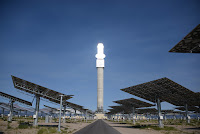A California firm is converting sunlight to heat and storing it in molten salt so it can supply electricity when the wind is calm or the sun isn’t shining
Deep in the Nevada desert, halfway between Las Vegas and Reno, a lone white tower stands 195 meters tall, gleaming like a beacon. It is surrounded by more than 10,000 billboard-size mirrors focusing the sun’s rays on its tip. The Crescent Dunes “concentrating solar power” plant looks like some advanced communication device for aliens. But the facility’s innovation lies in the fact that it can store electricity and make it available on demand any time—day or night.
Crescent Dunes, the flagship project of Santa Monica–based firm SolarReserve, has achieved what engineers and proponents of renewable energy have struggled with for decades: providing cheap, commercial-scale, non–fossil fuel electricity even when winds are calm or the sun is not shining. The facility is touted as being the first solar power plant that can store more than 10 hours of electricity, which translates into 1,100 megawatt-hours, enough to power 75,000 homes. “We can ramp up electricity generation for utilities based on the demand. We can turn on when they want us to turn on and we can turn off when they want us to turn off,” SolarReserve CEO Kevin Smith says.
The trick is to have all those mirrors heat up a massive tank fullof sodium and potassium nitrates that are pumped up to the top of the tower. There the molten salt can reach temperatures as high as 565 degrees Celsius. When electricity is needed, the hot salt is used to boil water and produce high-temperature, high-pressure steam, which turns turbines that generate electricity. The rest of the time, the molten salt can be stored in another insulated tank on the ground.
Molten salt’s physical and thermal properties make it a particularly good candidate for energy storage. It can be pumped just like water and stored in tanks just like water, says Cliff Ho, an engineer at Sandia National Laboratories who studies heat transfer and fluid mechanics for technologies such as concentrating solar power, but is not involved in Crescent Dunes. And although a handful of other concentrating solar plants around the world use solar rays to heat water directly into steam, it is much more volatile than molten salt and cannot be easily stored, Ho explains. That is why the Ivanpah Solar Electric Generating System in California, the world’s largest concentrating solar-thermal plant at 377 megawatts, has no way to store all the energy it produces.
Although a few other plants like the Solana Generating Station in Arizona have used molten salt as a storage medium, they heat the salt indirectly, using solar energy to first heat other fluids such as oil. The benefit of using molten salt as both the energy collector that creates steam and the energy storage mechanism, however, is that it eliminates the need for expensive heat exchangers to go between different fluids. And with molten salt, Crescent Dunes can operate at much higher temperatures than plants using other heat transfer fluids, which makes electricity generation more efficient, Smith says. Plus, the molten salt medium is cheaper, more environment-friendly, nontoxic, and nonflammable compared with oil.
But molten salt technology itself is not new. “What Crescent Dunes brings to the table is that it proves that we can use this technology with concentrated solar power to generate nonintermittent electricity,” says Yogi Goswami, a professor at the University of South Florida and an expert on solar power. The payoff, he adds, is that 10-hour storage eliminates the need for a fossil fuel power plant to back up electricity production on cloudy days and at peak usage hours in the evening. It also relieves anxiety for utilities concerned with overproduction of electricity by solar power plants during the day, which sometimes forces them to curtail electricity production or pay customers to take the extra power.
Read more at New Concentrating Solar Tower Is Worth Its Salt with 24/7 Power

No comments:
Post a Comment